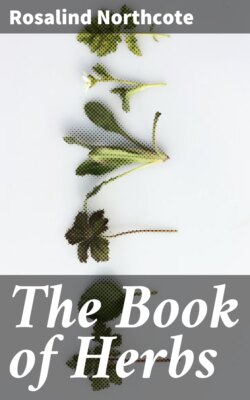Читать книгу The Book of Herbs - Rosalind Northcote - Страница 20
На сайте Литреса книга снята с продажи.
Cresses.
ОглавлениеTable of Contents
Darting fish that on a summer morn
Adown the crystal dykes of Camelot,
Come slipping o’er their shadows on the sand. …
Betwixt the cressy islets, white in flower.
Geraint and Enid.
To purl o’er matted cress and ribbed sand,
Or dimple in the dark of rushy coves.
Ode to Memory.—Tennyson.
Valley lilies, whiter still
Than Leda’s love and cresses from the rill.
Endymion.
Cresses that grow where no man may them see.
Ibid.
I linger round my shingly bars,
I loiter round my cresses.
The Brook.—Tennyson.
Cresses have great powers of fascination for the poets, and “the cress of the Herbalist is a noun of multitude,” says Dr. Fernie. Of these now cultivated, St. Barbara’s Cress (Barbarea vulgaris) has the most picturesque name, and is the least known. It was once grown for a winter salad, but American Cress (Erysimum præcox) is more recommended for winter and early spring. Indian Cress (Tropæolum majus), usually known as nasturtium, is seldom counted a herb, although it is included in some old gardening lists, for the sake of the pickle into which its unripe fruits were made. Abercrombie adds that the flowers and young leaves are used in salads, but this must be most rare in England; though, when once in Brittany, I remember that the bonne used to ornament the salad on Sundays with an artistic decoration of scarlet and striped nasturtium flowers. Garden Cress (Lepidium sativum), the tiny kind, associated in one’s mind since nursery days with “mustard,” used to be known as Passerage, as it was believed to drive away madness. Dr. Fernie continues, that the Greeks loved cress, and had a proverb, “Eat Cresses and get wit.” They were much prized by our poor people, when pepper was a luxury. “The Dutchmen[21] and others used to eate Cresses familiarly with their butter and breade, as also stewed or boyled, either alone or with other herbs, whereof they make a Hotch-Potch. We doe eate it mixed with Lettuce and Purslane, or sometimes with Tarragon or Rocket with oyle, vinegar, and a little salt, and in that manner it is very savoury.”
Water-Cress (Nasturtium officinale) is rich in mineral salts and is valuable as food. The leaves remain “green when grown in the shade, but become of a purple brown because of their iron, when exposed to the sun,” says Dr. Fernie. “It forms the chief ingredient of the Sirop Antiscorbutique, given so successfully by the French faculty.” “Water-Cress pottage” is a good remedy “to help head aches. Those that would live in health may use it if they please, if they will not I cannot help it.” This is Culpepper’s advice, but he relents even to those too weak-minded to avail themselves of a cure, salutary but unpalatable. “If they fancy not pottage they may eat the herb as a sallet.”
[21] Parkinson.
